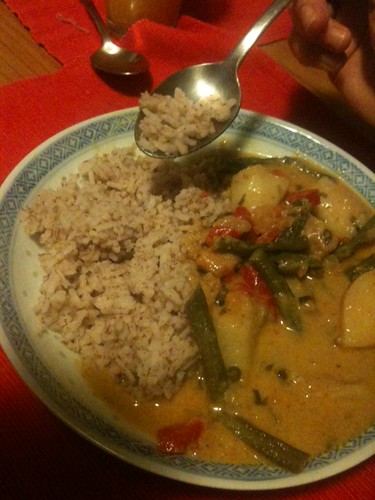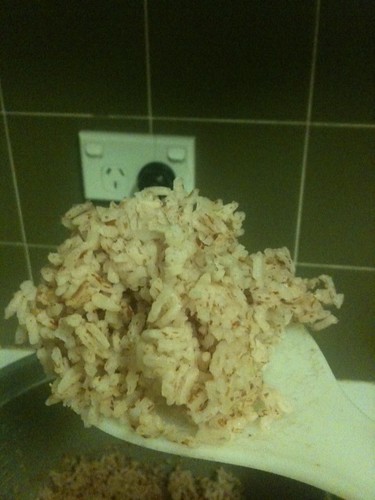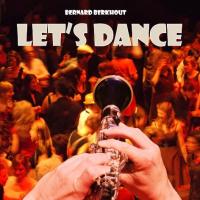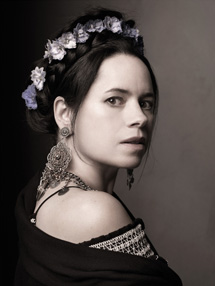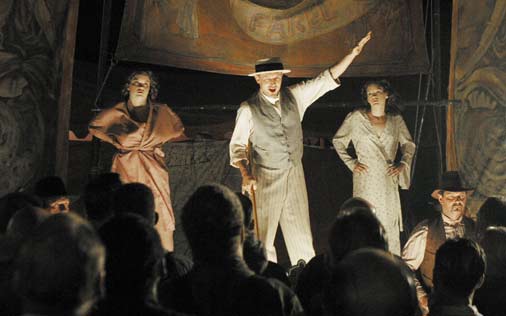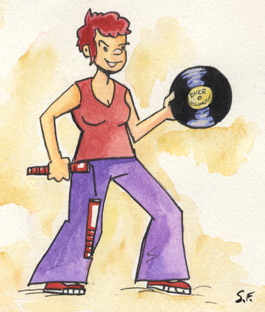
(This is a picture of me my friend Scott drew for my birthday)
I wrote in my last post: Bug’s Question Of the Day is a regular thread on Faceplant (just search for ‘Bug’s question of the day’ over there). I keep typing replies and then deleting them. I want to engage, but sometimes my responses are too long or too hardcore or too stroppy for that sort of public talk. Over here, I figure I can write my replies and keep them within the context of my blog and broader thinking about dance and DJing and gender and stuff…
This question is from the 16th July:
”At an upcoming blues event, I noticed there are six DJs – Five men and one woman. Another upcoming blues event this month has six men and one woman. Six out of six DJs at ILHC will be men. In general it seems that while there are some prominent female blues and Lindy DJs, the majority of DJs getting regional and national event gigs are male. Do you agree that this is true? Is it true in West Coast as well? If it’s true, why?”
There were all sorts of replies to the original question, some were quite shockingly sexist. I was surprised – stunned! – by serious comments from blokes that women simply don’t make good DJs because they have rubbish taste in music (too romantic or fluffy), can’t read the crowd, don’t obsess over music, aren’t competitive or … well, you can see where things are heading. I’m not surprised to read that sort of thing in a discussion by swing dancers. There are an awful lot of swing dancing idiots when it comes to gender stuff.
I want to include the replies in that thread before my comment, so you can see where my thinking was at when I wrote this. I wrote a shortish version of this post in reply to the comment there on FB, but it didn’t really do what I wanted it to do. Also, I was uncharacteristically cool in my reply. I think that’s because I hadn’t actually read the other comments properly. Yikes.
Byron Alley I’ll say that this isn’t my original opinion but I thought I’d share what a *female* DJ told me about this phenomenon. She said that the reason you don’t see as many female DJs in general, or as many DJing at the top level, is that she felt that to be a good DJ you need to have a kind of obsessive/competitive personality, the kind that makes you spend hours looking for the right new song, or digging up obscure facts about artists so that you can do a set of “songs from 1941 with the word “blue” in the title” that nobody is aware of but you.
Bear in mind that this came from a woman who was a DJ herself, so she wasn’t saying that NO women have these traits–just that more men do. I thought I’d post that because it wasn’t something that had occurred to me personally one way or another.
What I notice personally is that at the events I’ve run, where I’m always looking for good DJs and even to help train new ones, most of the time it’s guys. Guys are much more likely to volunteer, to think they can do it even when they’re not good at all, and ALSO to actually be good DJs. Women in my experience have been less likely to want to try it out, or to push for DJ slots. And of the few women who DJ, there are still fewer that have received good reviews. On average, the female DJ’s I’ve hired have been less likely to keep people dancing as long (eg. people go home earlier), keep the energy up, or get good reviews from other people. This isn’t even my own opinion–when I’ve been away and had other people DJ, I’ve asked my staff and patrons for feedback on all of our DJs and this has been the trend. I’m just passing on the results.
The three problems that have come up with the less skilled female DJs have been: 1) an overall lack of energy in sets (songs are more likely to be chill, subtle, even romantic), 2) less ability or inclination to read the crowd in deciding what to play next, and 3) less extensive music collections than many of the male DJs, leading to less ability to find “just the right song” for the moment.
On the very interesting plus side, even the mediocre female DJs were more likely to get good reviews…. from other women! So this had led me to wonder if maybe part of the problem is that most of our venues have fewer men than women. If the female DJs appeal more to the women but not the men, then it’s possible that what happens is that the men want to dance less even though the women want to dance more, which leads to everyone being even less satisfied because everyone dances less.
I expect to get flamed my above comments either way, but I need to at least point out that some of my very favourite DJs are women. Locally in Ottawa we have Claudia Petrilli, Jody Glanzer and Natalia Rueda. Natalia was actually a huge exception to everything–I heard her spin her first set and she was literally good from day one. (Not like I’m biased…) And globally Tina Davis is one of my favourite DJs ever.
The last thing I’ll say is that a lot of research has shown that women tend to negotiate less than men for jobs in general. A female friend of mine did research in that area. And in the swing scene, a lot of how people get gigs is by putting themselves out there, contacting organizers and saying “I’m available, pick me” and working out a deal. So even if the number of great DJs is equally distributed among both genders despite all I’ve written here, I’d be willing to bet that fewer women are running after DJ slots than men. I know that once again, my personal experience strongly confirms that.
I’ll end by saying that in a dance scene where there are more women than men dancing, I’d really LOVE to see more female DJs. I don’t think anyone should be pushed into doing something they don’t love, but then again, I never wanted to DJ until circumstances forced me to, and I’ve learned to love it over time.
And ladies… if you’re a great DJ, then get out there, contact the organizers of events you’re interested in and MAKE them hire you. It may work better than you think.
17 July at 00:23 · Like · 3 people
Greg Avakian Yes, it’s true.
Men are more geeky about collecting stuff. It is to a large degree how we define ourselves. “I have this and that”. Yes, it’s generalization and no doubt there are women who have great jazz and blues collections (Tina Davis, Devona Cartier, Suzanne Sluizer, Emily Smith etc.), but when I see a bunch of people who self-identify as DJs, they are usually men. Or boys.
What does it mean? Ladies, get involved!
17 July at 00:27 · Like · 1 person
Greg Avakian Interesting comment Byron about the music that women tend to choose. I agree -and considering that *for fusion dance events* I tend to like stretchier, subtle rhythms and chill vibes, I thought that (- in general -) the women who applied to this year’s fusion exchange kicked the men’s asses.
PS: I agree also that you will get flamed. :P
17 July at 00:34 · Like
Andrew Harrington This doesn’t answer the question at all, but is it maybe the same phenomenon that leads more men to become musicians?
17 July at 01:14 · Like
Stephanie Robinson Out of curiosity, do you think leaders and followers have different relationships to the music that would lead them to pursue/not pursue DJing? As a follow, I follow my lead before I follow the music–that is to say, I try to dance in ways that will fit the music, but I first defer to my lead and whether he’s giving me the space to get creative. When i dance with a new or rhythm challenged lead who is not keeping time with the music, I will follow his off-count lead out of politeness (and I die a little inside each time I do it).
Do leads, who are entrusted with being creative for 2 people in ways that fit the music, have a different relationship to the music than follows?
17 July at 01:26 · Like
Denise Shepler bluesSHOUT this year has 2 men and 6 women, so I’d say that’s an indication that there are good female dj’s out there.
17 July at 01:35 · Unlike · 5 people
Bob Free I think it really depends on the venue – I have nearly 50% male/female DJs at my venue – but I do have to work hard to maintain that balance (women DJs are harder to line up, because there are fewer of them and they are in demand). Many of the venues I go to, the instructor DJs – so it depends on who is teaching.
17 July at 01:35 · Unlike · 1 person
John Joven Maybe it just depends on the scene. In Chicago blues dancing, there are 5 females and 4 males who regularly spin at the blues events.
17 July at 02:05 · Like
Larry Colen I think there may be more woman djs at DHB this weekend. Last night I think it was 2 men and 4 women
17 July at 02:20 · Like
Elizabeth Gonzalez I thought this was part of ‘stacking the dance floor with good dancers’ as alluded to in the other BQOTD about event planning…
17 July at 02:55 · Like
Anna Sutheim The Minneapolis scene is actually somewhat skewed towards female DJs.
I would hazard a guess that scenes in which male organizers and teachers are predominant also have mostly male dj’s, and vice versa.
17 July at 04:38 · Unlike · 1 person
Devona Cartier over all across the lindy and blues scenes, there ARE more men djs then women djs. i think its far better balanced in the blues scene, than for swing though.
I feel strongly that there is no fundamental reason why women cant be just as good at djing as men, or why they wouldnt be just as interested. also, i feel that there isnt any fundamental difference in the type of music men or momen would pick. the reason there might be differences is more an issue of environment than gender. …more to come…
17 July at 05:22 · Like · 1 person
Claudia Petrilli well, I’ll be damned. Since I was tagged, now I feel like I need to add my two cents.
I have to say that I CERTAINLY have a Geeky/nerdy/obsessive-compulsive type of personality and that I have spent many an hour “looking for the right new song, or digging up obscure facts about artists”. Was this what lead me to become a decent DJ? I definitely think so. If it wasn’t the main factor, it definitely played a major role. Getting to be a decent dancer obviously helped, as well.
And while I enjoy “chill, subtle, even romantic songs” they are not my favourite to DJ. I was shocked that just a couple of days ago, Natalia Rueda commented that a certain -very good, lead in our scene might like my sets so much because I tend to play mostly slow song. That burned. But I do have to say that as the night progresses, I do tend to mellow out my sets. Depending of the crowd, that is. It always depends of the crowd. And the event. But right now I’m mostly talking about weekly dances, not events with a theme. Lots of thinking and re-thinking to do here.
17 July at 06:38 · Like
Devona Cartier for me personally:
1) i did not start djing because i was a collector of music. im not a person who is obsessive over sidemen and statistics. honestly i care much less about who the artist is, what the song title is, what year it was recorded, or what album it is from. it has been explained to me in the past that ‘the reason more men dj then women is because men are into those kinds of details (like they are with sports) and women are not’. aside from the fact that i dont even know if that is true of men and women across the board, i dont think that is required to be a good dj, much less makes you one.
when i began djing i knew very little about those kinds of details. i knew what my music collection sounded like, and i could put songs together based on an intuitive sense of how songs suited each other and the crowd. over the years, i have explored why i intuit what works and have learned detailed, concrete, information about the music. the details become interesting not based on themselves, but how they relate to each other, and the pattern as a whole. for example, knowing the recording date of a song allows me to compare it to other tunes of that year and what the dance style of that year was, to gain understanding of what kinds of sounds influence dance in what way. then i can watch what the dancers are doing in front of me and match their dance style with a particular sound that suits it.
do i come at djing from an intuitive place because im a woman? i dont know. (also i dont think i care.) i DO hear it said that ‘to be a dj you should know the specific details of the music such as x, y, and z.’ i think thats a load of crap and if its keeping more intuitive types of people from starting to dj then its a shame. to be a good dj you need to know and understand your music. even knowing who the artist is doesnt really matter. knowing the patterns and elements of the music is far more important, and you dont need to give a damn about how many home runs someone had in their career.
2) I do not tend towards “chill, subtle, romantic songs”. i would be insulted if someone assumed as much because im a woman. actually i would be insulted id someone assumed anything about how i dj based on my gender. as i cycle through the female djs i know i dont think thats true of them either. Byron Alley its possible that that is something local to your area.
i also think that its possible that ladies having less inclination to read the crowd may just be something that is true locally to you. it is not true in my experience. among the imtermediate level djs i have expernce with women are MORE likely to change what they had in mind to play to suit what the crowd wants, and men are more likely to just plow through with their music agenda.
collection size: it does not make a good dj. i know people who have very large collections and are very poor djs. i also know djs who have smaller collections who are fantastic. i would expect that anyone starting out as a dj would have a smaller collection, which is probably not really a bad thing seeing as they have more oppertunity to learn their collection well.
17 July at 08:38 · Like · 4 people
Devona Cartier the competitive spirit: yes, you are more likely to succeed as a dj if you have it. women are just as competitive (if not more so) as men. conside how many women enter jack and jill comps.
i do believe that women are more likely to underestimate themselves, and that men are more likely to overestimate themselves. You will get more gigs if you are pushy about your abilities.
again, me personally: i know im a kick ass dj. I endevor to wipe the floor with all other djs. i do not contact events and tell them they should hire me. i am certian that leads to me getting less gigs. im just not comfortable “boasting” to events like that. i have no idea if that is a tendance of women, but if it is, well thats a good reason that there are more men hired.
lastly: i think the real reason that there arent more women djs, is that their arent many women djs. it like out of sight out of mind. women may not even consider it because its just something other women arent doing. atleast, one of the reasons there are more up and coming djs who are women in the blues scene, is there were more women djs already.
17 July at 09:04 · Unlike · 5 people
Susan Brannigan Whenever a question like this comes up, I suspect what Devona said above: women are, for whatever reason, more likely to underestimate themselves and men are more likely to overestimate themselves.
I used to teach skiing, and there were traditionally 9 levels where skiers would rank themselves. Men most frequently thought they were better skiers than they actually were, while women often though themselves less skilled than they actually were. Why is this? I have some ideas about this, but there’s probably no good reason to get into it now. ;)
I’m glad to hear there are a lot of female DJs out there. I would like to see/hear more. :)
Tuesday at 02:33 · Like
Clyde Wright DC seems to have about an even number of male/female Blues DJs. In WCS, there seems to be more men than women. In Lindy men edge out the women by a tad. Argentine Tango seems fairly well split. Salsa, there’s more men than women. I think it varies between city and scene dramatically.
Tuesday at 05:07 · Like
Damon Stone Without any planning, DHB had exactly 2 men on the planning staff out of 10 positions, 4 male teachers out of 10, and 2 male deejays out of 7. I don’t know what that has to say about anything, except that this isn’t really too unusual for us. Our deejays were awesome, and I have some pretty damn exacting standards and prerequisites for my deejays. There are certainly a number of women who are excellent deejays in the circles I run around.
Tuesday at 07:05 · Like · 3 people
Luckily Devona Cartier was there to set those idiots straight. She made some brilliant comments – things that were just plain old common sense. I haven’t heard Devona DJ, but she’s been around for a while, and I’ve heard many good things about her work. I especially liked the way she declares: “I know I’m a kick ass DJ. I endeavour to wipe the floor with other DJs.” It’s exciting to hear a sister stepping up and declaring pride in her abilities, but also competitive confidence. Here I am, if you think you’ve got it, bring it. But prepare to be pwnd.
At any rate, I wrote some things in reply to all this. What follows is what I wrote at the time, but didn’t actually post on FB.
I think Devona makes a brilliant point: there aren’t more women DJs because there aren’t women DJs. I think you need critical mass (ie a certain number of visible women DJs), good support and encouragement for new women DJs and then working conditions which continue to encourage women DJs.
My suspicion about DJing: It’s like cycling. The key indicator for numbers of cyclists in a city is whether women feel safe cycling. If women feel safe cycling in your city, you numbers of cyclists will be high over all. I also think that if you have lots of women DJs in your scene, you probably have a pretty good DJing culture. Good as in supportive, collaborative, creatively challenging, exciting, stimulating, rewarding, etc. As Devona says, women DJs like to kick your arse as well. They just might need to be encouraged to get their boots on in the first place.
I can only speak about Australian DJs, and then only from my own POV. I’ve been DJing since 2005, managing DJs at big events since 2006 and I also coordinate DJs for local events. I haven’t traveled overseas to DJ, but I have DJed interstate at most Australian events. My experience has been with blues and lindy DJing. I have a long way to go before I become anywhere as near as good as some of the international DJs I’ve danced to or heard.
I’d suspect that most of the comments above mine apply to a US context. This is important because these national scenes have different DJing cultures and different approaches to remunerating DJs for large, small and medium sized events. There are specific local DJing cultures even within Australia.
Firstly, the women DJs that I have met and worked with in Australia are just as likely to be crazed, obsessive music collectors as men, are just as likely to obsess about software and hardware, to fuss about working a crowd or managing relationships with event coordinators, to pour ridiculous amounts of money into their collections, to jump on the chance to nerd out in music conversations. They just don’t always talk about it in the same way as men. Or shout out their opinions in public fora.
Secondly, the ability to DJ well, to combine songs creatively, to work a crowd, to develop and know a good collection, isn’t gender specific. I know as many excellent female DJs as male and I have good, satisfying and creative working relationships with both men and women DJs.
Thirdly, it’s difficult to quantify the women/men DJs in Australia. I suspect women, who may make up a larger proportion of DJs at at smaller local events are underpresented at larger interstate events.
If I were to make an observation about gendered tropes in DJing, it would be that women DJs tend to nurture professional relationships in different ways. They’re more willing to take direction from event managers, they’re less confrontational and they’re more collaborative in their relationships with other DJs (particularly other women DJs).
I’ve also noticed that some male DJs are more willing to put themselves forward for gigs and to get them (even if they’re not that skilled), and for some women DJs to be less confident about their skills and to miss out on gigs (even thought they had better skills). I’ve also noticed that women will step up if they get even a little bit of encouragement. But men are less likely to actively say “what was good about my set? what sucked? how can I improve?” This is most true of DJs who’ve been around for a while.
But there are exceptions to these tropes. I’ve worked with difficult, stroppy, pain in the arse women DJs, and I’ve worked with collaborative, socially right-on male DJs. I’m also defining ‘good DJs’ according to a particular set of criteria which reflect who I am and how I work on events. I will not tolerate rude, aggressive or threatening behaviour from anyone, whether DJ or organiser. I need DJs to be on time to gigs, to take feedback at the event and before. As a DJ I need to be treated with respect – I will not tolerate rudeness or being fucked about. I am also committed to good working conditions for DJs at events I’m involved in.
It’s important to note: no Australian event pays to fly DJs in to an event. No event pays DJs more than $30 an hour, most pay $20 or $25 per hour. We only started paying DJs in about 2003 (depending on event and city). There’re only 3 events that don’t give DJs both free entry and pay for the gig they work. I believe that all DJs should get free entry + basic pay if it’s a big event. If your event can’t afford DJs, then you need to rethink how you prioritise items in your budget.
A quick note about the comparative ‘value’ of live music and DJed music: while I would prioritise live bands for dances (because they’re fun), they’re not always a viable option (cost, lack of contacts, venue restrictions, etc). DJs are an important part of many swing, blues and balboa scenes. Simply put, if you want to dance, you have to have music. If I’m running an event the two most important things in my budget are a) music, and b) dance floor. If I can’t get a good band, I’ll get a DJ. To not pay that DJ is to say to them “I do not value your work, and I do not value music.” Or, more realistically “I won’t pay you because I’m pretty sure I can get away with fucking you over. You’ll be so grateful for the gig you won’t challenge my arsehattery.” I’m not particularly keen on attending an event that places so little importance on music.
Local events may pay their DJs and give them free entry, may just give free entry, may just pay. It’s usually negotiated individually. Again, I always pay DJs and always give them free entry, because they’re what make a DJed social night work. I don’t distinguish between new or experienced DJs in that respect.
This low pay is no doubt a key factor affecting who gets into DJing. If it paid more, I reckon we’d see more DJs, and different DJ behaviour.
In all these cases, it’s possible to make gender less important. As a DJ coordinator for larger events, I actively encourage newer DJs who have promise, no matter what their gender. I also seek out DJs that I mightn’t have heard of, or who mightn’t have approached me for gigs. I try to see as many DJs as I can when I travel to events, I maintain contacts in other cities and grill them about their up and coming DJs, and I ask dancers which DJs they most enjoyed.
This way I’m not relying on DJs presenting themselves to me; I can seek them out. I’m also prepared to take risks with newer DJs or lower profile DJs if I think they might be ninjas. I just put some support structures in place at events so we can recover if something goes wrong (eg put them in non-crucial spots, make sure I’m around if they need me, have an experienced DJ ride shotgun for them, make sure they know I’m happy to answer questions at any time).
I also try to give useful, supportive feedback to DJs I work with and I encourage DJs to give me feedback in return. I try not to approach giving feedback as ‘you tell me what you love and hate about me, I’ll tell you what I love and hate about you’ because that’s nasty. I’ve recently learnt that it’s more useful to say “Ok, we had some problems at point X. What was your experience? How would you have changed things?” and I wait til they’ve told me their opinion before I offer mine. I’ve found doing this talk in person is more effective than in email, especially with female DJs. ie female DJs just don’t answer emails with these questions, whereas male DJs are more likely to. I think the body language and chance to make sure both of us are on the same page in person is more encouraging for women DJs. I find that the least flexible DJs are least willing to do this sort of talk. I’m less willing to hire the sorts of DJs who aren’t open to feedback because I get sick of telling them to stop doing X because it makes me cranky and forces confrontations.
Some traits are gendered: women are often more collaborative, men can be more aggressive and assertive. But there’s no reason a man can’t learn to be collaborative or a woman assertive. You just have to be prepared to fuck up a few times, to take feedback gracefully, to employ that feedback, and to be ok with being wrong. You also have to be ok with being _right_ and to pursue the stuff you love and are good at. Or want to be good at. I think men are often less willing to risk losing face (through being wrong) and women are less likely to risk confrontation by assuming they’re right.
I think the fact that I’m a woman affects how I work with women and men DJs as a DJ and as a DJ coordinator for events. I hire DJs who are professional, and I won’t waste my time with some arsehat who’s aggressive, difficult and unprofessional. No matter how good a DJ they are. I’ve known other (male) DJ coordinators who wouldn’t share that approach. But then, I’ve also known female DJ coordinators who don’t tolerate bullshit from difficult DJs, and male DJ coordinators who hate conflict and won’t tell a pain in the arse DJ when to step back.
Numbers of Sydney DJs: There are about 7 lindy DJs with solid skills, and only 2 of them are men. We have a few more blues DJs (3 or 4 male DJs), and there are a few floating lindy DJs who DJ occasionally. All the larger fortnightly social events (blues and lindy) here are managed by women.
When I was living in Melbourne (I started DJing there, and left in 2008) there were slightly more women DJs than men holding down the regular local gigs and not seeking out high profile slots, in lindy, blues and balboa. But more men DJed the bigger events. I don’t know what numbers are like now.
I coordinated DJs for MSF (one of Australia’s larger events) in Melbourne this year, and we had 8 DJs in a live-music heavy program. 5 DJs were women, 3 were men. I preselected for musical style (to suit the event’s program), professionalism (will be on time, have all their gear, be easy to work with, etc), proven track record as a DJ (ie mad skillz), public interest (ie DJs who’re popular with dancers atm), availability (some DJs on my short list were traveling o/s, couldn’t commit to the gig in time, etc etc). The hardest thing to do is knock a DJ back. It breaks my heart to tell a ninja DJ who’s also tops to work with that the program is full as a goog and can’t squeeze in another DJ.
When I was learning to DJ, and now, I’ve noticed that women DJs, particularly new women DJs, but also experienced women DJs, at local and larger events, are almost always far more likely to work collaboratively with other women DJs to learn new things, and to figure out how a sound set up works. They’ll huddle over the sound desk, physically quite close, saying things like “What do you think?” and “What if we tried this?” and “Do you reckon…?” In a similar situation most male DJs will say “It works like this” or “The set up at X is like this, so this much work here too”.
Some men will work collaboratively, but they are almost always less likely to say “I don’t understand” or “I don’t know how that works” or “What do you think?” Particularly if they’ve been DJing for a while. There are exceptions, but they are in the minority.
I do both approaches – I’m pushy but I also try to be collaborative. :D

